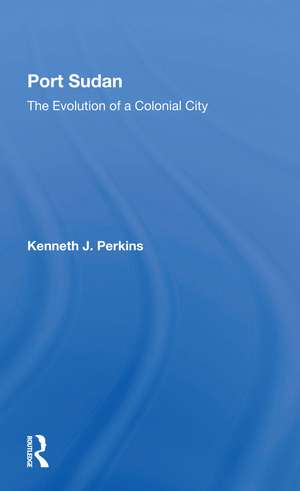Port Sudan: The Evolution Of A Colonial City
Autor Kenneth J Perkinsen Limba Engleză Paperback – 9 noi 2020
Preț: 261.33 lei
Preț vechi: 312.12 lei
-16% Nou
Puncte Express: 392
Preț estimativ în valută:
50.01€ • 51.66$ • 41.62£
50.01€ • 51.66$ • 41.62£
Carte tipărită la comandă
Livrare economică 26 martie-09 aprilie
Preluare comenzi: 021 569.72.76
Specificații
ISBN-13: 9780367299385
ISBN-10: 0367299380
Pagini: 264
Dimensiuni: 152 x 241 x 33 mm
Greutate: 0.52 kg
Ediția:1
Editura: Taylor & Francis
Colecția Routledge
Locul publicării:Oxford, United Kingdom
ISBN-10: 0367299380
Pagini: 264
Dimensiuni: 152 x 241 x 33 mm
Greutate: 0.52 kg
Ediția:1
Editura: Taylor & Francis
Colecția Routledge
Locul publicării:Oxford, United Kingdom
Cuprins
A Note on Sources -- A Note on Transliteration -- Introduction -- Creating Colonial Cities -- 1904–1918 -- “An Ideal Site for a Town”: Putting “the Most Desirable People in the Most Desirable Plots” -- Harboring Doubts: The Utility of a New Port, the Status of Egypt, the Availability of Labor, and Other Early Problems -- 1919–1942 -- Port Sudan Between the Two World Wars -- The Crystallization of Disparity: District Commissioners, General Managers, “Trim Smug Villas…and Hideous Wooden Shacks” -- Working the Port: Merchants, Contractors, Beja Stevedores, and Yemeni Laborers -- Government Services in a City of Contrasts: Public Health, Public Works, Public Safety, and Public Education -- Looking Outward: Unwanted Pilgrims, Troublesome Italian Neighbors, and a Disruptive War -- 1943–1953 -- A Community in Flux: Social Problems, Labor Questions, and Political Issues in Post-War Port Sudan -- Epilogue -- Appendix
Notă biografică
Kenneth J. Perkins is professor of history at the University of South Carolina.
Descriere
This study examines the efforts of Port Sudan's builders and early administrators to tailor the urban environment to their own notions of the ideal colonial city–how it should look, how it should function, and how its human components should interact.
